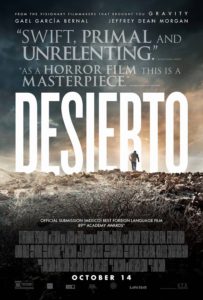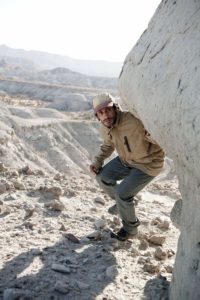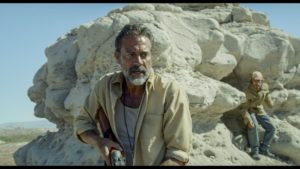 While attempting to cross the unforgiving desert terrain at the Mexican and United States border, a journey seeking a better life turns into a fight for survival, when Moises (Gael García Bernal) and a group of migrants encounter a murderous, rifle-toting vigilante (Jeffrey Dean Morgan) who has taken on border patrol duties as his personal mission.
While attempting to cross the unforgiving desert terrain at the Mexican and United States border, a journey seeking a better life turns into a fight for survival, when Moises (Gael García Bernal) and a group of migrants encounter a murderous, rifle-toting vigilante (Jeffrey Dean Morgan) who has taken on border patrol duties as his personal mission.
Eight years ago, while traveling through Arizona, writer/director Jonás Cuarón was invited by the Mexican consulate to tour their facilities. In the course of the visit, he was told numerous tragic stories of border crossings through the most transited entrance into the United States, sparking his interest in the subject.
“I live in the U.S. and at that time, Arizona was starting anti-immigration laws,” stated Cuarón. “There was starting to be a very strong rhetoric of hatred to the migrant, the foreigner, the others, so I really wanted to make a movie about this, but I didn’t know the best way to approach the story.”
Cuarón’s inspiration came from the 1970’s. He admired how filmmakers during that time managed to make political and subversive films disguised as genre films. In Desierto, the director disguised the political aspects of illegal immigration within a story that played as a thriller, full of action and suspense.
Place was a major character in the film. Turning points in the plot were dependent upon very specific locations. When Cuarón wrote the first draft, he had never visited the desert, so he built the settings based upon archetypes he had in mind such as the web of thorns and the labyrinth of stones. During the four years while he was working with his father Alfonso Cuarón on Gravity, he spent his free time visiting various deserts in the U.S. and Mexico. He even traveled to Almería in Spain where Sergio Leone shot many of his movies.
Unlike Gravity, where the challenge was to create the imagined reality of the script, Cuarón explained, “Since the reality actually existed, as I travelled to all these deserts, I started adapting the script to the landscapes that I had found. The challenge was to find a desert that gave me all the different landscapes that I needed close to each other. The closest I was able to find was La Paz in Baja California.”
The presence of Saguaro cacti in Baja, helped to sell the area as Arizona, but even near La Paz, where sites were relatively close, changing locations was “logistically a nightmare” because it took two hours via dirt roads to access areas, which also had “snakes and heat.” A couple of the scenes were shot in California near the border.

The first draft of Desierto was written before Gravity. Man against a harsh environment, is a theme common to both films. Cuarón described the idea’s evolution, “I showed it to my dad. He became very interested about this concept of doing a movie that was straight non-stop action with almost no dialogue, just with visual metaphors, so you could talk about different subject matter. We adapted it to space. Desierto and Gravity are very different stories because of the context, but the concepts are similar.”
During the four years working on Gravity, Cuarón learned from his father, bringing that experience to bear when he returned to finesse the screenplay of Desierto. He was able to attach García Bernal and producer Alex Garcia. Once the project started taking shape, he began thinking of different directors of photography to work with, including Damian Garcia.
“I had just seen Güeros, which I really admired, so I became interested in working with Damian,” shared Cuarón. “As soon as I met with him, I could tell he was going to be perfect because he was someone who had the same desire I had to take good care of the light, to have a very pristine frame as much as the desert light allowed. He also always understood that it had to be a very dynamic film, so we had to have lots of coverage and a very aggressive camera.”
All the lighting was natural with the use of bounces. One scene shot at dusk – the magic hour – was very stressful since there is only a twenty-minute window during which to shoot. The company shot the scene over 5 days, capturing one take a day. One night scene around the campfire was lit by the firelight.
The script was very descriptive of the landscape, serving as a guide to the cinematography. Cuarón discussed with Garcia the use of extreme wide shots for capturing the landscape, juxtaposed with tight close-ups of the characters. Cuarón was happy that the director of photography understood that both types of shots were thematically important to the story.
One of the crewmembers Cuarón could not have made the film without was the animal handler. When he read all the specific actions for the dog in the script, García Bernal joked that they did not need a dog; they needed Marlon Brando. When the director’s dad read all the scenes with the animal, he suggested they be cut out, especially since the movie had a tight budget.
Cuarón knew the dog was a window into Morgan’s vigilante, adding dimension to a character that otherwise could have become a stereotypical villain. With no supporting actors on that side of the story, the dog allowed Morgan to bring out the “emotional, human side” of the part.
“I looked for dogs everywhere. Besides Hollywood budgets being out of my reach, many cinema dogs I saw didn’t have the violence I needed, ” revealed Cuarón. “I ended up finding this animal handler in Mexico that doesn’t work in cinema. He trains dogs for security purposes. When I saw his dogs, they could not only do what I needed, they could do more. I had to rewrite the script to incorporate all these cool stunts the dogs could do.”
Cuarón credited producer, Alex Garcia for believing in the project from early on and understanding that every time the production grew, it was for the betterment of the film. He also credited his line producer, Nicolás Celis, for managing the limited budget, stretching it to get what they needed, while never putting the safety of the production at risk. Cuarón also noted Celis created a tight team, despite working sixteen-hour days in the desert.

“By the end of ten weeks, you might have expected everyone would have revolted, but Nico managed to create this sense of community,” admitted Cuarón. “Food is the other important key, particularly when you are on location. Catering is what controls the mood of the crew.”
Editing was essential for this film. Even though the conditions were harsh and time was limited, the production shot a lot of coverage because it would help the editing “be dynamic.” As a director who is also an editor, Cuarón understood the importance of having options in post. Crew and actors on set think that once the master is filmed, the performance is great, and the shot is beautiful, it is time to move on, but when production is finished they all disappear and the editor has to make it work. “That is why I force them to give me all the set-ups I ask for,” said Cuarón.
In regards to editing his own film, the director commented, “That’s when you get to make your film.” It is one of his favorite parts of the filmmaking process, because everything he has been building from writing, casting, shooting comes together. He compares the all the work up to post as “getting your paints ready on the palette, while editing is actually doing the painting.” As in the script process, he used his father and uncle as collaborators during the edit. Because of the closeness of the relationship, they have developed a communication shorthand.
“I really admire the cinema they make. I trust the criticism they give is always very honest. If they don’t like something, they will never lie, but they’re also very respectful. If I don’t agree with them, they’ll never impose their vision.” Cuarón added, “Also besides them, what I really like about the Mexican film community is that once I started editing, there were many director’s I admired that were willing to watch the film and give me their notes. It’s very important to have that extra pair of eyes.”





